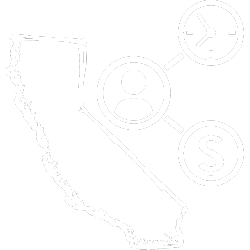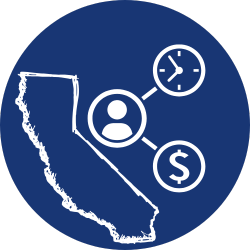Your Path to Recovery
If you’ve been affected by recent wildfires, floods or other declared disasters, California has resources to support your recovery every step of the way. We know that getting back on your feet can feel overwhelming—but you’re not alone.
Outsmart Disaster is here to help you rebuild with confidence. This page is your one-stop guide to navigating the recovery process—from the first steps you should take after a disaster, to accessing financial assistance, filing insurance claims, and finding local and federal support.
Let’s move forward together—toward recovery, resilience, and a stronger future.

Immediately After a Disaster
When disaster strikes, the first few steps you take can make a big difference. This section walks you through essential actions to protect your people, assess the damage, and start your recovery. Stay calm, stay focused, and use these guidelines to begin moving forward safely and effectively.
Check In, Stay Safe, and Respond Quickly
- Account for all employees: Confirm the safety and well-being of staff, customers, and visitors.
- Follow emergency alerts: Evacuate or shelter-in-place as needed and address immediate hazards.
- Assess health risks: Report injuries and assist with emergency medical care if required. Call emergency if required.
- Check for ongoing threats: Be aware of potential aftershocks, flooding, or secondary hazards.
Record & Report damages
- Take photos and videos: Document damage to property, equipment, and inventory for insurance claims.
- Keep records: Save receipts for any immediate repairs or emergency purchases.
- Report the incident: Notify local emergency management, law enforcement, or other relevant agencies if required.
- Secure damaged areas: Prevent further loss by boarding up broken windows or shutting off utilities if necessary.
Communicate
- Contact employees: Use an established communication plan to inform staff about next steps.
- Inform stakeholders: Notify customers, suppliers, and partners of any service disruptions.
- Leverage social media and website: Share updates to keep customers informed about the business status.
- Engage with local community resources: Connect with local business organizations or chambers of commerce for support.
Contact Insurance Providers
- Initiate a claim: Report the damage to your insurer as soon as possible.
- Understand your policy: Review coverage details to plan for recovery costs.
- Document all interactions: Keep track of claim numbers, adjuster contacts, and key conversations.
Assess the Impact
- Inspect the premises: Check for structural damage and ensure utilities like gas, electricity, and water are safe to use.
- Evaluate operational capacity: Determine what resources are available to resume operations.
- Review data backups: Ensure critical business records and customer data are intact and accessible.
- Assess employee availability: Confirm workforce capacity and address any staffing challenges.
Activate Your Resiliency Roadmap
- Follow pre-established procedures: Use the Resiliency Roadmap to identify next steps for restoring operations.
- Relocate if needed: Move operations to an alternate site if your primary location is compromised.
- Seek expert guidance: Work with business continuity specialists, legal advisors, or disaster recovery experts if needed.
Secure Financing
- Evaluate cash flow needs: Identify gaps and seek short-term funding if necessary.
- Tap into resources: Consider lines of credit, FEMA and SBA disaster assistance. For FEMA assistance call (800) 621-3362 or visit disasterassistance.gov.
- Explore local and state aid: Look into grants or emergency relief programs available in your area.
Reopen and Resume Services
- Implement phased reopening: Focus on core functions first, then expand to full operations.
- Communicate with customers: Share your reopening plans and any changes in services or hours.
- Verify supply chain stability: Confirm vendor availability and restock critical inventory.
- Ensure compliance: Meet any required health and safety regulations before reopening.
Review and Update your Resiliency Roadmap
- Analyze the response: Identify strengths and weaknesses in how your business handled the disaster.
- Update your Resiliency Roadmap (Business Continuity Plan (BCP)): Incorporate lessons learned to improve future resilience.
- Train your team: Conduct refresher training on emergency response and continuity planning.
- Test your plan: Schedule drills or tabletop exercises to strengthen preparedness for the next disruption.

Financial Assistance and Active Disaster Declarations
Active Disaster Declarations and Application Process
Check if your area is included in an active federal disaster declaration.
Visit DisasterAssistance.gov and click “Apply Now” to check eligibility.
How to apply for disaster assistance through FEMA?
- Confirm eligibility
- Create an account on Login.gov
- Gather your personal information
- Fill out the application
- Review and send your application
Federal Emergency Management Agency (FEMA)
The Federal Emergency Management Administration (FEMA) oversees the applications process for Individual Assistance (IA) and Public Assistance (PA).
Individual Assistance (IA) is available to individuals and households who have sustained losses as a direct result of a disaster that receives a federal disaster declaration.
Public Assistance (PA) can fund the repair, restoration, reconstruction or replacement of eligible public or certain nonprofit facilities or infrastructure damaged or destroyed by a disaster.
FEMA Disaster Assistance Frequently Asked Questions
FEMA Disaster Recovery Centers (DRCs) are facilities and mobile offices set up in or near affected communities, in an area that offers equal access and resources to everyone after a disaster. FEMA staff may be able to guide you to the help you need . after a disaster. DRCs are open to all disaster survivors.
Watch this video to learn more about FEMA Disaster Recovery Centers.
Visit a Disaster Recovery Center (DRC) to:
- Learn about disaster assistance programs
- Apply for disaster assistance
- Check the status of your FEMA application
- Help you understand FEMA notices or letters
- Find Housing and rental assistance information
- Get referrals to agencies that offer other assistance
- Meet with a Small Business Administration (SBA) agent
How do you locate you nearest Disaster Recovery Center?
- FEMA Disaster Recovery Center (DRC) Locator Tool
- Text DRC and a ZIP Code to 43362 [Example: DRC 93230]
Questions? Contact the FEMA Helpline at 1-800-621-FEMA (3362).
For assistance in identifying and applying for FEMA disaster assistance, you may also contact your local Small Business Center.
US Small Business Administration (SBA)
The US Small Business Administration provides low-interest disaster loans to help businesses and homeowners recover from declared disasters.
Watch this video to learn more about how SBA loans can help you recover after a disaster.
Types of SBA Disaster Loans
Physical Damage Loans – Loans to cover repairs and replacement of physical assets damaged in a declared disaster.
Economic Injury Disaster Loans – Funding to cover small business operating expenses after a declared disaster.
Mitigation Assistance – Expanded funding to make improvements to eliminate future damage.
Military Reservist Loan – SBA provides loans to help eligible small businesses with operating expenses to make up for employees on active duty leave.
How to Get Disaster Assistance through the SBA?
- Check For Active Disaster Declarations
- Apply for a Disaster Loan
- Check Your Status
Contact the SBA’s Customer Service Center at disastercustomerservice@sba.gov, or at (800) 659-2955. Individuals who are deaf or hard-of-hearing may call (800) 877-8339.
Completed applications should be mailed to U.S. Small Business Administration, Processing and Disbursement Center, 14925 Kingsport Road, Fort Worth, TX 76155.
For assistance in identifying and applying for SBA disaster assistance, you may also contact your local Small Business Center.
CA Infrastructure and Economic Development Bank (IBANK)
IBank offers loan programs for businesses affected by disasters in California.
IBank, a unit within California Governor’s Office of Business and Economic Development (GO-Biz), offers the following loan programs for businesses from one to 750 employees (small businesses):
DISASTER RELIEF LOAN GUARANTEE PROGRAM (DRLGP)
IBank will issue loan guarantees up to 95 percent of the loan through its partner Financial Development Corporations to help small business borrowers who were impacted by disasters or public safety power shutoffs and who need term loans or lines of credit for working capital. Small businesses, including small farms, nurseries, agriculture-related enterprises and nonprofits that have suffered an economic loss Resources for Businesses and/or physical damage may apply. This disaster program will help lenders and small businesses by providing loan guarantees of up to $1 million for small business borrowers in declared disaster areas.
JUMP START LOAN PROGRAM
IBank is offering loans from $500 to $10,000 to low-wealth entrepreneurs in the declared disaster and emergency areas through its Jump Start Loan Program. IBank established the Jump Start Loan Program in 2016 as a small loan and financial literacy/technical assistance program designed for low-income small businesses in low-wealth communities, including businesses owned by women, minorities, veterans, people with disabilities and those previously incarcerated. Access to IBank’s Disaster Relief Loan Guarantee Program and Jump Start Loan Program can be made through its partner Financial Development Corporations (FDCs)
For more information on how to apply, visit the IBANK website
Contact Information
1-916-341-6600
California State Treasurer's Office
Designed to provide up to 100% coverage on certain loan defaults.
CALIFORNIA CAPITAL ACCESS PROGRAM (CalCAP)
Find more information at the California State Treasurer’s Office website.
The California Capital Access Program for Small Business (CalCAPSB or Program) encourages banks and other financial institutions to make loans to small businesses that have difficulty obtaining financing. If you own a small business and need a loan for start-up, expansion or working capital, you may receive more favorable loan terms from a lender if your loan is enrolled in the CalCAP Loan Loss Reserve Program. This program helps communities by providing financing to businesses that create jobs and improve the economy. Loans are available up to $5 million.
CalCAP is a loan loss reserve program which may provide up to 100% coverage on losses as a result of certain loan defaults. With CalCAP portfolio support, a lender may be more comfortable underwriting small business loans.
If your business is in an economically distressed geographic area, also known as a “Severely Affected Community” (SAC), your loan may be eligible for credit enhancements. To complete the SAC certification form, visit the California’s State Treasurer’s Office Website.
Check to see if your commercial lender or financial institution participates in or find a participating lender. If your financial institution does not currently participate, it is easy for lenders to sign up. Please have your institution complete the Financial Institution Application and send to CalCAP to get started.
To find a participating lender, visit the CalCAP Participating Financial Institution Contact List
Financial Institution Application available
Email completed applications to the Treasurer’s Office, calcap@treasurer.gov.
Contact Information
California State Treasurer’s Office website
(916) 653-2995
US Department of Agriculture (USDA)
When a tornado, flood, or drought strikes, or a quarantine is imposed by the Secretary of Agriculture, or when other natural disasters occur, FSA’s Emergency loan program is there to help eligible farmers and ranchers rebuild and recover from sustained losses.
Emergency Farm Loans
The Emergency loan program is triggered when a natural disaster is designated by the Secretary of Agriculture or a natural disaster or emergency is declared by the President under the Stafford Act. These loans help producers who suffer qualifying farm related losses directly caused by the disaster in a county declared or designated as a primary disaster or quarantine area. Also, farmers located in counties that are contiguous to the declared, designated, or quarantined area may qualify for Emergency loans.
For production losses, a 30% reduction in a primary crop in a designated or contiguous county is required. Losses to quality, such as receiving a 30% reduced price for flood damaged crops, may be eligible for assistance, too.
USDA Emergency Loan Program Factsheet
California Disaster Relief Recovery and Resilience Fund
The League of California Community Foundations and Philanthropy California direct monetary donations to the California Disaster Relief Recovery and Resilience Fund, which deploys resources to impacted communities through community foundations.

State Resources
CA Board of Equalization
If your property has been damaged by a recent natural disaster, you may be eligible for property tax relief. In many cases, the damaged property can be reappraised in its current condition, with some taxes refunded to the property owner.
Once rebuilt, the property’s pre-damaged value will be restored.
Owners of eligible property may also apply for deferral of the next property tax installment on the regular secured roll or tax payments on the supplemental roll, without penalties or interest. The disaster must be the result of a Governor-proclaimed state of emergency. When a timely claim for deferral is filed, the next property tax installment payment is deferred without penalty or interest until the county assessor has reassessed the property and a corrected tax bill has been sent to the property owner.
For a chronological List of Governor-Proclaimed Disasters, visit the CA Board of Equalization website.
CLAIM FILING
More details about claim filing can be found at the CA Board of Equalization website. To qualify for property tax relief under section 170, you must file a claim with the county assessor within 12 months from the date of damage or destruction, or the time specified in your county ordinance, whichever is later. There must be at least a $10,000 estimated loss of current market value to qualify the property for this relief.
Visit the County Assessor’s Office for more information.
After an application is processed by the county assessor’s office, a notice of proposed new assessment will be sent to you. Subsequently, a separate supplemental refund will be made based on the amount of reduction. The refund will be prorated from the month in which the disaster occurred to the end of the fiscal year or completion of new construction, whichever is first. You do not have to file a separate claim for refund. However, you must still pay your regular tax bill.
The form and its title differ from county to county; therefore, you must contact your county assessor for an application for reassessment for property damaged or destroyed by misfortune or calamity. In some cases, the form may be downloaded from the county’s website. You may find your assessor’s contact information by visiting the Listing of County Assessors.
DISASTER RELIEF QUICK REFERENCE CHART
More details about resources available.
While section 170 is one form of relief that may be available when a disaster strikes, depending on the nature of your property, you may be eligible for additional relief. The chart below lists additional relief that may be available to you based on property type and the type of disaster that occurred. The listed Revenue and Taxation Code will provide the requirements of each relief option.
Contact Information
CA Board of Equalization website
1-800-400-7115
CA Department of Tax and Fee Administration
Business owners and other tax and fee payers affected by natural disasters may request extensions to file returns and relief from penalties and/or interest.
Tax and fee payers for the programs below can request relief from penalties and/or interest and ask for an extension of time to file their tax or fee returns either by visiting our website or by calling CDTFA’s Customer Service Center toll-free at 1-800-400-7115 (TTY: 711), Monday through Friday from 8 a.m. to 5 p.m. (Pacific time), excluding state holidays.
Read more about Tax Relief During a State of Emergency
EXTENSION OF FILING DEADLINE
An extension of up to three months* to file and pay taxes or fees is available in all of the following CDTFA administered programs:
- Alcoholic Beverage Tax
- California Tire Fee
- Cannabis Tax
- Childhood Lead Poisoning Prevention Fee
- Cigarette and Tobacco Products Tax
- Covered Electronic Waste Recycling Fee
- Diesel Fuel Tax
- Emergency Telephone Users Surcharge
- Energy Resources Surcharge
- Fire Prevention Fee
- Hazardous Waste Activity Fee
- Hazardous Waste Disposal Fee
- Hazardous Waste Environmental Fee
- Hazardous Waste Facility Fee
- Hazardous Waste Generator Fee
- Integrated Waste Management Fee
- Interstate User Diesel Fuel Tax
- Jet Fuel Tax
- Lead Acid Battery Fees
- Lumber Products Assessment Fee
- Marine Invasive Species Fee
- Motor Vehicle Fuel Tax
- Natural Gas Surcharge
- Occupational Lead Poisoning Prevention Fee
- Oil Spill Response, Prevention, and Administration Fee
- Prepaid Mobile Telephony Services (MTS) Surcharge
- Regional Railroad Accident Preparedness and Immediate Response Fee
- Sales and Use Tax
- Timber Yield Tax
- Underground Storage Tank Maintenance Fee
- Use Fuel Tax
- Water Rights Fee
This relief is offered to any business owner or feepayer who was directly affected by the disasters in the counties listed above, and who, as a result, cannot meet their filing and payment deadlines. The CDTFA has also extended the deadline for filings that were delayed by disruption of service of the United States Postal Service or private mail and freight companies.
*Effective September 9, 2016, the extension available for tax or fee payers affected by a disaster was increased from one-month to up to three months (Assembly Bill 1559).
ONLINE RELIEF REQUEST OF INTEREST AND PENALTIES
Relief from interest and penalties may be provided for those persons who are unable to file their returns and pay taxes and fees when due. This relief may be provided for the programs listed above. To request a filing extension or relief from interest and penalties visit our Relief Request webpage.
Request Relief at the CA Department of Tax and Fee Administration website
Please note: The relief program for interstate user tax under the International Fuel Tax Agreement (IFTA) applies to California tax only. California is unable to waive interest and penalties for another jurisdiction. For information regarding IFTA, please call our Customer Service Center at 1-800-400-7115.
International Fuel Tax Agreement (IFTA) at the CA Department of Tax and Fee Administration website
COPIES OF CDTFA TAX RECORDS
Business owners and fee payers who need to obtain copies of CDTFA tax records will be able to receive replacements free of charge. To obtain copies of critical tax records on file with the CDTFA, please call us toll-free at 1-800-400-7115. These forms may include copies of prior tax returns filed with the CDTFA, audits, or permit applications.
Contact Information
CA Department of Tax and Fee Administration website
1-800-400-7115
CA Employment Development Department (EDD)
Provides services to individuals and business affected by disasters in CA. EDD staff is located throughout the state and are often at Local Assistance Centers to provide: assistance with filing claims for Unemployment Insurance (UI) benefits, job search assistance, and general support, referrals, and resources.
WAITING WEEK FOR UNEMPLOYED BENEFITS WAIVED
Governor’s Emergency Proclamations usually waive the non-payable one-week waiting period for regular Unemployment Insurance (UI) benefit payments to eligible individuals affected by current disasters. This means individuals can be paid benefits for the first week they are unemployed due to the disaster.
The UI program provides partial wage replacement benefits to workers who lose their jobs, or have their hours reduced, through no fault of their own. Learn more about the Unemployment Insurance program and eligibility requirements for collecting benefits.
For more information on the UI Program, visit the CA Employment Development Department website
EXTENSIONS FOR EMPLOYERS TO FILE AND PAY PAYROLL TAXES
Employers directly affected by a disaster may request up to a 60-day extension of time from the EDD to file their state payroll reports and/or deposit state payroll taxes without penalty or interest.
For more information about how to request an extension and other employer assistance available, visit Emergency and Disaster Assistance for Employers at the CA Employment Development Department website
You can also learn about assistance available through the Internal Revenue Service’s Help During Disasters web page at the Internal Revenue Service website.
OTHER DISASTER-RELATED EDD SERVICES
JOB SEARCH ASSISTANCE
In disaster situations, our EDD Workforce Services representatives will often be available along with our UI and Tax representatives in Local Assistance Centers that may be established by the State OES. They can provide a wide range of job search assistance and employer support services, as well as other general support, referrals, and resources.
For Job Assistance, visit the CA Employment Development Department website.
For Employer Support Services, visit the CA Employment Development Department website.
For California’s online job exchange system, visit the CalJOBS website.
DISABILITY INSURANCE BENEFITS
Disability Insurance (DI) provides partial wage replacement benefits to eligible California workers who are unable to work due to a non-work-related illness, injury, or pregnancy. If you were injured by the disaster, you may be eligible for DI benefits.
To apply for DI benefits, submit a Claim for Disability Insurance (DI) Benefits (DE 2501) using SDI Online or by mail. If you need a paper version of the DE 2501, you can order the form through the Online Forms and Publications page or contact DI by phone.
Contact Information
CA Employment Development Department website
- English: 1-800-300-5616
- Spanish: 1-800-326-8937
- Cantonese: 1-800-547-3506
- Mandarin: 1-866-303-0706
- Vietnamese: 1-800-547-2058
- TTY: 1-800-815-9387
Read more about EDD Disaster Related Services
CA Department of Insurance (CDI)
Aids with questions about insurance or dispute with an insurer. Consumers can visit the CDI website to review essential Top Ten Tips, obtain information from Resources page, and submit a complaint if they are experiencing insurance related problems. CDI staff are also located at Local Assistance and Disaster Recovery Centers for one-on-one assistance.
The CA Department of Insurance (CDI) is available to provide assistance with questions about insurance or a dispute with your insurer. The Department has prepared guides on understanding key insurance items, preparing, and making a claim and how to avoid fraud after disaster. Consumers can visit the CDI website to review essential Top Ten Tips, obtain information from the Resources page, and submit a complaint if they are experiencing insurance related problems. CDI staff are also located at Local Assistance and Disaster Recovery Centers for one-on-one assistance.
Contact Information
1-800-927-4357
Franchise Tax Board
Taxpayers may deduct a disaster loss for any loss sustained in California that is proclaimed by the Governor to be in a state of emergency.
California law generally follows federal law regarding the treatment of losses incurred because of a casualty or a disaster.
CASUALTY LOSS
If your property is lost or damaged due to an earthquake, fire, flood, or similar event that is sudden, unexpected, or unusual, and insurance or other reimbursements do not repay you for the damage to your property, you will usually qualify for a casualty loss deduction.
DISASTER LOSS
For California purposes, a casualty loss becomes a disaster loss when both of the following occur:
- You sustain the loss in an area the President of the United States or the Governor of California declares a state of emergency.
- You sustain the loss because of the declared disaster.
STATE TAX RELIEF
State tax relief is available for taxpayers impacted by natural disasters. Write Name of Declared Disaster in red ink at the top of the tax return to alert FTB the return is disaster-related. (NOTE: this information has not been updated on the FTB website at the time of this publication but follows previous announcements such as the Carr Fire.)
COPIES OF TAX RETURNS
Taxpayers who are survivors of a disaster may also receive free copies of state returns to replace lost or damaged ones. Taxpayers may complete Form FTB 3516, Request for Copy of Tax Return and print the name of the disaster in red ink (for example, Camp Fire) at the top of the request.
Contact Information
1-800-852-5711
Department of Consumer Affairs - Contractors State License Board (CSLB)
The Contractors State License Board (CSLB) verifies contractor licenses, investigates complaints, and provides helpful information about hiring a licensed contractor.
For information on hiring or filing a complaint regarding a contractor, disaster victims may call CSLB’s Disaster Hotline M-F from 8 a.m. – 5 p.m.
Contact Information
Department of Consumers Affairs – Contractors State License Board website
1-800-962-1125
24-hour automated telephone response system:
1-800-321-CSLB (2752)
Employment Training Panel - Rapid Employment Strategies Pilot on Natural Disasters – RESPOND
The Panel implemented RESPOND Pilot Program in order to help mitigate the devastating effects to workers and industries.
Contact Information
1-916-327-5640
CA Governor’s Office of Business and Economic Development (GO-BIZ)
GO-Biz offers a range of services to business owners and has dedicated representatives to field general business questions and to assist business owners as they seek to access business recovery resources.
California Business Investment Services (CalBIS)
The California Business Investment Services (CalBIS) Unit provides no-fee, tailored site selection services to employers, corporate real estate executives, and site location consultants who are considering California for relocation and/or expansion.
Our staff is available to help identify the advantages of considering California locations for business relocation and expansion.
In addition to site selection, the CalBIS team assists businesses with a wide array of incentives, resources, and services including:
- Financial assistance and loan programs
- Labor availability and education information
- State and local permit assistance
- Transportation and infrastructure information
- Information on tax credits and other incentive programs
Contact Information
1-877-345-4633
Office of Permit Assistance
The Permit Assistance Unit offers comprehensive permit and regulatory compliance assistance to all businesses in California by serving as the central source of permit guidance.
Knowledgeable staff helps new business owners identify the permits needed to start a new business or expand an existing one. To help streamline the permitting process, Permit Specialists may schedule pre-application meetings between businesses and the appropriate regulatory agencies. When necessary, staff can act as a neutral third-party facilitator between businesses and local, state, and/or federal regulatory agencies to resolve permitting issues. All these services are free and confidential.
For a comprehensive list of GO-Biz’ programs and more information, visit the GO-Biz website.
Contact Information
Permit & Regulatory Assistance
1-877-345-4633
California Office of the Small Business Advocate
1325 J Street, Suite 1800
Sacramento, CA 95814
Speaker Request Form
Stay informed. Subscribe:
CalOSBA Newsletter
State Funding Programs
CA Grants Portal











